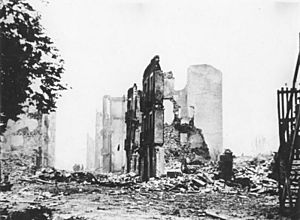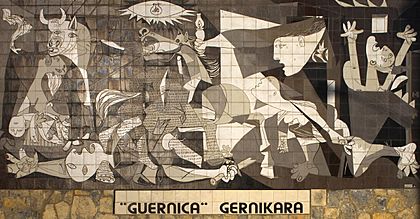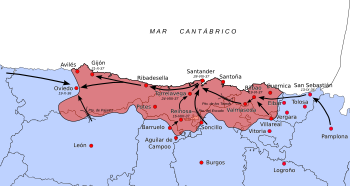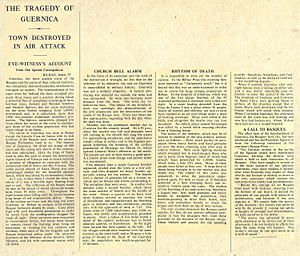Bombing of Guernica facts for kids
Quick facts for kids Operation Rügen |
|
|---|---|
| Part of the Spanish Civil War | |
 Ruins of Guernica (1937) |
|
| Type | Aerial bombing |
| Location | Guernica, Basque Country, Spain |
| Planned by | National Defense Junta |
| Objective | |
| Date | 26 April 1937 16:30 – 19:30 (CET) |
| Executed by | |
| Casualties | ~150–1,650 (estimates vary) killed |
On 26 April 1937, the Basque town of Guernica (Gernika in Basque) was aerial bombed during the Spanish Civil War. It was carried out at the behest of Francisco Franco's rebel Nationalist faction by its allies, the Nazi German Luftwaffe's Condor Legion and the Fascist Italian Aviazione Legionaria, under the code name "Operation Rügen". The town was being used as a communications centre by Republican forces just behind the front line, and the raid was intended to destroy bridges and roads. The operation opened the way to Franco's capture of Bilbao and his victory in northern Spain.
The attack gained controversy because it involved the bombing of civilians by a military air force. Seen as a war crime by some historians, and argued as a legitimate attack by others, it was one of the first aerial bombings to capture global attention. Under the international laws regarding aerial warfare in 1937 Guernica was a legitimate military target. The number of victims is still disputed; the Basque government reported 1,654 people killed at the time, while local historians identified 126 victims (later revised by the authors of the study to 153). A British source used by the USAF Air War College claims 400 civilians died. Soviet archives claim 800 deaths on 1 May 1937, but this number may not include victims who later died of their injuries in hospitals or whose bodies were discovered buried in the rubble.
The bombing is the subject of the anti-war painting Guernica by Pablo Picasso, which was commissioned by the Spanish Republic. It was also depicted in a woodcut by the German artist Heinz Kiwitz, who was later killed fighting in the International Brigades, and by René Magritte in the painting Le Drapeau Noir. The bombing shocked and inspired many other artists, including a sculpture by René Iché, one of the first electroacoustic music pieces by Patrick Ascione, musical compositions by Octavio Vazquez (Gernika Piano Trio), René-Louis Baron and Mike Batt (performed by Katie Melua), and poems by Paul Eluard (Victory of Guernica), and Uys Krige (Nag van die Fascistiese Bomwerpers, English translation from the Afrikaans: Night of the Fascist Bombers). There is also a short film from 1950 by Alain Resnais titled Guernica.
Contents
Guernica
Guernica (Gernika in Basque; officially Gernika-Lumo), in the Basque province of Biscay, and 30 kilometres east of Bilbao, has long been a centre of great significance to the Basque people. Its Gernikako Arbola ("the tree of Gernika" in Basque) is an oak tree that symbolises traditional freedoms for the Biscayan people and, by extension, for the Basque people as a whole. Guernica was considered a key part of the Basques' national identity; it was also considered the spiritual capital of the Basque people and long celebrated as "the home of Basque liberties". Guernica was also the location of the Spanish weapons manufacturer Astra-Unceta y Cía, which had been a supplier of firearms to the Spanish military and police forces since 1912. At the time of the bombing, the population of Guernica was 7,000 people, and the battlefront was 30 kilometres away.
Military situation
Advances by Nationalist troops led by Generalísimo Francisco Franco had eaten into the territory controlled by the Republican Government. The Basque Government, an autonomous regional administrative body formed by Basque nationalists, sought to defend Biscay and parts of Guipuzcoa with its own light Basque Army. At the time of the raid, Guernica represented a focal strategic point for the Republican forces. It stood between the Nationalists and capture of Bilbao. Bilbao was seen as key to bringing the war to a conclusion in the north of Spain. Guernica also was the path of retreat for the Republicans from the northeast of Biscay.
Prior to the Condor Legion raid, the town had not been directly involved in the fighting, although Republican forces were in the area; 23 battalions of Basque army troops were at the front east of Guernica. The town also housed two Basque army battalions, although it had no static air defenses, and it was thought that no air cover could be expected due to recent losses of the Republican Air Force.
Market day
Monday 26 April was market day; there were more than 10,000 people in the former Basque capital. Generally speaking, a market day would have attracted people from the surrounding areas to Guernica to conduct business. Market days consisted of local farmers bringing in their crops to sell to the village people. They would bring the crops of the week's labour to the main square, which is where the market was held.
There is a historical debate over whether a market was being held that particular Monday as, prior to the bombing, the Basque government had ordered a general halt to markets to prevent congestion of roads, and restricted large meetings. It is accepted by most historians that Monday "...would have been a market day".
Luftwaffe doctrine, 1933–1942
James Corum states that a prevalent view about the Luftwaffe and its Blitzkrieg operations was that it had a doctrine of terror bombing, in which civilians were deliberately targeted in order to break the will or aid the collapse of an enemy. After the bombing of Guernica in 1937, Wieluń and Warsaw in 1939, and Rotterdam in 1940, it was commonly assumed that terror bombing was a part of Luftwaffe doctrine. During the interwar period the Luftwaffe leadership officially rejected the concept of terror bombing, but continued to allow bombings which might result in heavy civilian casualties:
The vital industries and transportation centres that would be targeted for shutdown were valid military targets. It could be claimed civilians were not to be targeted directly, but the breakdown of production would affect their morale and will to fight. German legal scholars of the 1930s carefully worked out guidelines for what type of bombing was permissible under international law. While direct attacks against civilians were ruled out as "terror bombing", the concept of attacking vital war industries-and probable heavy civilian casualties and breakdown of civilian morale-was ruled as acceptable.
General Walther Wever compiled a doctrine known as The Conduct of the Aerial War in 1935. In this document, which the Luftwaffe adopted, the Luftwaffe rejected Giulio Douhet's theory of terror bombing. Terror bombing was deemed to be "counter-productive", increasing rather than destroying the enemy's will to resist. Such bombing campaigns were regarded as a diversion from the Luftwaffe's main operations, destruction of the enemy armed forces.
The raid
The Condor Legion was entirely under the command of the Nationalist forces. The order to perform the raid was transmitted to the commanding officer of the Condor Legion, Oberstleutnant Wolfram Freiherr von Richthofen, from the Spanish Nationalist Command.
Mission planning
While questions are often raised over the intent of the raid, the diaries of the planner and commander of the mission made public in the 1970s indicate that an attack on Guernica represented part of a wider Nationalist advance in the area and was also designed to support Franco's forces already in place. According to Payne:
Guernica was selected as a target by Lieutenant Colonel Wolfram von Richthofen (younger cousin of the “Red Baron” of World War I), chief of staff of the Condor Legion, for several reasons. It housed several battalions of troops and three arms factories, lay near the front lines, and was connected by means of an adjacent bridge to the road flanking the main Basque defensive position, along which the defenders might have to retreat. Richthofen’s chief goal was to block a main junction near the front to stymie Basque troop movements and permit Mola to break through, encircling the forces farther north... Pinpoint bombing was impossible with the existing technology, and the only way to hit the targets was to carpet much of the area.
Richthofen, understanding the strategic importance of the town in the advance on Bilbao and restricting Republican retreat, ordered an attack against the roads and bridge in the Renteria suburb. Destruction of the bridge was considered the primary objective since the raid was to operate in conjunction with Nationalist troop movements against Republicans around Marquina. Secondary objectives were restriction of Republican traffic/equipment movements and the prevention of bridge repair via the creation of rubble around the bridge.
On 22 March 1937 Franco started to put his plan into action, starting with his air chief, General Alfredo Kindelán. The German army would first take the Guadalajara front. Italians then would be restructured at Palencia. From there two new divisions were formed. General Emilio Mola would start the campaign against the north (Asturias, Santander and Biscay). All Nationalist equipment was sent to the north front to support Mola. The main reason to attack first from the north was the suspicion that a decisive victory could be won there quickly. Mola wanted to make this fight quick; he let the Basque people know that if they wanted to surrender he would spare their lives and homes. On 31 March Mola's threat was put into action and the fighting began in Durango.
The Condor Legion persuaded Franco to send troops to go north and to be led by General Emilio Mola. On 31 March 1937, Mola attacked the province of Biscay, which included the bombing of Durango by the Condor Legion. Republicans put up a tough fight against the German troops but eventually were forced back. Many refugees fled to Guernica for safety, about a thousand people turned to Guernica. On 25 April, Mola sent a warning to Franco saying that he was planning a heavy strike against Guernica.
To meet these objectives, two Heinkel He 111s, one Dornier Do 17, eighteen Ju 52 Behelfsbomber, and three Italian Savoia-Marchetti SM.79 of the Corpo Truppe Volontarie were assigned for the mission. These were armed with 250 kg (550 lb) medium high-explosive bombs, 50 kg (110 lb) light explosive bombs and 1 kg (2.2 lb) incendiaries. The ordnance load for the 24 bombers was 22 tonnes (22 long tons; 24 short tons) in total. A follow up to the bombing raid was also planned for the next day involving Messerschmitt Bf 109 raids in the area. The order was noted on 26 April by Richthofen as:
Starting at once: A/88 and J/88 for free fighter bomber mission on the streets near Marquina-Guernica-Guerriciaz. K/88 (after Returning from Guerriciaz), VB/88 and Italians for the streets and the bridge (including suburb) east of Guernica. There we have to close the traffic, if we finally want a decision against personnel and materiel of the enemy. Vigon agrees to move his troops for blocking all streets south of Guernica. If this succeeds, we will have trapped the enemy around Marquina.
First five waves of raid
The first wave arrived over Guernica around 16:30. A Dornier Do 17, coming from the south, dropped approximately twelve 50 kg (110 lb) bombs.
The three Italian SM.79s had taken off from Soria at 15:30 with orders to "bomb the road and bridge to the east of Guernica, in order to block the enemy retreat" during the second wave. Their orders explicitly stated not to bomb the town itself. During a single 60-second pass over the town, from north to south, the SM.79s dropped thirty-six 50 kg (110 lb) light explosive bombs. César Vidal says that at this point, the damage to the town was "relatively limited... confined to a few buildings", including the church of San Juan and headquarters of the Izquierda Republicana ("Republican Left") political party.
The next three waves of the first attack then occurred, ending around 18:00. The third wave consisted of a Heinkel He 111 escorted by five Regia Aeronautica Fiat CR.32 fighters led by Capitano Corrado Ricci. The fourth and fifth waves were carried out by German twin-engined planes. Vidal notes:
If the aerial attacks had stopped at that moment, for a town that until then had maintained its distance from the convulsions of war, it would have been a totally disproportionate and insufferable punishment. However, the biggest operation was yet to come.
Subsequent raids
Earlier, around noon that day, the Junkers Ju 52s of the Condor Legion had carried out a mission around Gerrikaraiz. Following this they landed to re-arm and then took off to complete the raid on Guernica. The attack would run from north to south, coming from the Bay of Biscay and up the course of the Urdaibai estuary.
The 1st and 2nd Squadrons of the Condor Legion took off at about 16:30, with the 3rd Squadron taking off from Burgos a few minutes later. They were escorted from Vitoria-Gasteiz by a squadron of Fiat fighters and Messerschmitt Bf 109Bs of Günther Lützow's 2. Staffel (2nd Squadron) of Jagdgruppe 88 (J/88), for a total of twenty-nine planes. Lützow himself did not participate in the attack, he was on home leave from 8–29 April 1937.
From 18:30 to 18:45, each of the three bomber squadrons attacked in a formation of three Ju 52s abreast—an attack front of about 150 m (490 ft). At the same time, and continuing for around 15 minutes after the bombing wave, the Bf 109Bs and Heinkel He 51 biplanes strafed the roads leading out of town, adding to civilian casualties.
Outcome
The bombing shattered the city's defenders' will to resist, allowing the rebel Nationalists to overrun it. This indirectly supported Douhet's theory, which predicted this result. The rebels faced little resistance and took complete control of the town by 29 April. The attacks destroyed the majority of Guernica. Three-quarters of the city's buildings were reported completely destroyed, and most others sustained damage. Among infrastructure spared were the arms factories Unceta and Company and Talleres de Guernica along with the Assembly House Casa de Juntas and the Gernikako Arbola. Since the Luftwaffe was then operating on Wever's theory of bombing as a military action, the mission was considered a failure as a result. However, the rubble and chaos that the raid created severely restricted the movement of Republican forces.
Since his appointment on the northern front, the Soviet aviation advisor Arjénoukhine had insistently called for air reinforcements, motivating his demands by high losses inflicted by nationalist aviation over Republican troops as well as civilian population.
On 8, 9 May I-15 and 6 R-Zet were sent by air from central Spain through Toulouse, in France. Planes were immediately immobilized by non-intervention committee, and later sent back unarmed to central Spain.
Casualties
The number of civilian fatalities is now set at between 170 and 300 people. Until the 1980s it had been generally accepted that the number of deaths had been over 1,700, but these numbers are now known to have been exaggerated. Historians now agree that the number of deaths was under 300.
An early study by Gernikazarra Historia Taldea estimated the number of victims to be 126, later revised to 153, and is still considered by the organisation to be provisional. Those incomplete data roughly correspond to the mortuary records of the town that survived, and do not include the 592 deaths registered in Bilbao's hospital. Raúl Arias Ramos in his book La Legión Cóndor en la Guerra Civil states that there were 250 dead. The study by Joan Villarroya and J.M. Sole i Sabate in their book España en Llamas. La Guerra Civil desde el Aire states that there were 300 dead. These studies, cited by historians such as Stanley Payne and Antony Beevor as well as media such as the BBC and El Mundo, provide the currently recognized death toll in those numbers.
After Nationalist forces led by General Emilio Mola's forces took the town three days later, the Nationalist side claimed that no effort to establish an accurate number had been made by the opposite side. The Basque government, in the confused aftermath of the raids, reported 1,654 dead and 889 wounded. It roughly agrees with the testimony of British journalist George Steer, correspondent of The Times, which estimated that 800 to 3,000 of 5,000 people perished in Guernica. These figures were adopted over the years by some commentators. These figures are represented in a majority of the literature from that period and up to the 1970s.
The Nationalist junta gave a patently false description of the events (claiming that the destruction had been caused by Republicans burning the town as they fled) and seems to have made no effort to establish an accurate number. At an extreme low, the Francoist newspaper Arriba claimed, on 30 January 1970, that there had only been twelve deaths.
Material damages
The numbers regarding the level of material destruction of the city still vary depending on the author and on what type of damages are being taken into account. Salas Larrazábal estimated that the bombs destroyed 14% of the local buildings. Cástor Uriarte (1970) estimated a total of 74% of the buildings were destroyed, mainly due to the fire that could not be extinguished until the next day.
Legacy
The bombing gained immediate international media attention because of the alleged intentional targeting of civilians by aerial bombers, a strategy widely recognized as "deviant", causing "international horror".
Steer's reports on the horrors of Guernica were greatly appreciated by the Basque people. Steer had made their plight known. The Basque authorities later honored his memory by naming a street in Bilbao George Steer Kalea, and commissioning a bronze bust with the dedication: "George Steer, journalist, who told the world the story about Guernica."
Despite Francoist efforts to play down the reports, they proliferated and led to widespread international outrage at the time.
Reactions to and condemnation of the bombing of Guernica is regarded by some historians as a turning point in the construction of the modern concept of human rights.
Picasso's painting

Guernica quickly became a world-renowned symbol of civilian suffering resulting from conflict and inspired Pablo Picasso to adapt one of his existing commissions into Guernica. The Spanish Republican Government had commissioned a work from him for the Spanish pavilion at the Paris International Exposition. Though he accepted the invitation to display a piece, he remained uninspired until he heard of the bombing of Guernica. Before the bombing of Guernica took place, Picasso never cared much for anything to do with politics. Once Picasso heard the news he changed his commissioned work for Spain into a reflection on the massacre.
Picasso began the painting on 11 May 1937, working on a piece of unbleached muslin (349 cm x 776 cm). Since the work was so large, Picasso had to use a ladder and a long-handled brush to reach the furthest corners of the canvas. He spent over two months creating Guernica. He used only black and white paint to invoke the truth-telling authority of documentary photography.
The display of Picasso's work at (Republican) Spain's Pavilion during the 1937 World's Fair in Paris reflected the effect on public consciousness. The painting, later adopted as a symbol of Basque nationalism during the Spanish transition to democracy, was displayed near Mercury Fountain, an overtly political work by Alexander Calder that incorporated mercury from the mines of Almadén. Today it resides in Museo Nacional Centro de Arte Reina Sofía in Madrid. A tapestry copy of Picasso's Guernica is displayed on the wall of the United Nations building in New York City, at the entrance to the Security Council room. It was placed there as a reminder of the horrors of war.
René Iché
Immediately after the bombing French sculpture René Iché created Guernica, one of his most violent and personal sculptures. He was shocked and horrified by the enormous civilian massacre and worked endlessly on the plaster statue. Iché used his daughter to model a child's body. He refused to display his work. Just after his death, an exhibition was held to commemorate the artist. This piece was displayed for a short time, then returned to his family.
German apology
Recrimination for the activities of the Condor Legion and shame at the involvement of German citizens in the bombing of Guernica surfaced following German reunification in the 1990s. In 1997, the 60th anniversary of Operation Rügen, then German President Roman Herzog wrote to survivors apologizing on behalf of the German people and state for Germany's role in the Civil War in general. Herzog said he wished to extend "a hand of friendship and reconciliation" on behalf of all German citizens. This sentiment was later ratified by members of the German Parliament who went on to legislate in 1998 for the removal of all former Legion members' names from associated German military bases.
70th anniversary
On the 70th anniversary of the bombing, the president of the Basque Parliament met with politicians, Nobel Peace Prize winner Adolfo Pérez Esquivel, and deputies from Hiroshima, Volgograd, Pforzheim, Dresden, Warsaw, and Oswiecim, as well as several survivors from Guernica itself. During the meeting they showed images and film clips of the bombing, took time to remember the 250 dead, and read the Guernica Manifesto for Peace, pleading that Guernica become a "World Capital for Peace".
2016 film
The 2016 film Guernica leads up to and culminates in the bombing of Guernica, set against the background of personalities involved in press coverage of the war.
See also
- Condor Legion
- Aviazione Legionaria
- Bombing of Chongqing, 1938-1943
- Bombing of Wieluń
- Bombing of Tokyo
- Battle of Aleppo (2012–2016)
- Guernica (painting)




